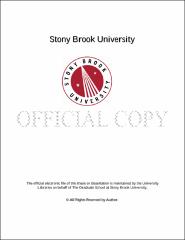| dc.identifier.uri | http://hdl.handle.net/11401/76628 | |
| dc.description.sponsorship | This work is sponsored by the Stony Brook University Graduate School in compliance with the requirements for completion of degree. | en_US |
| dc.format | Monograph | |
| dc.format.medium | Electronic Resource | en_US |
| dc.language.iso | en_US | |
| dc.publisher | The Graduate School, Stony Brook University: Stony Brook, NY. | |
| dc.type | Dissertation | |
| dcterms.abstract | The failure of philosophical concepts of the natural environment and of the works of landscape art structured from it to fully describe the perceptual experience of landscape, like the failure of site plans to adequately represent such works, can be attributed to the ocularcentricity that has long infected the notion of landscape. When " kinesthesia" replaces " vision" as the essential perception in the landscape experience, landscape is both conceived and represented more adequately. I define landscape art as " an expressive art that shapes the experience of moving through immersive volume as a structured sequence of both kinesthetic and visual perceptions to produce a continuum of specific feeling." The macro-scale bodily movements required to traverse a landscape, as well as the retinal movements involved in scanning voluminal space, produce kinesthetic perceptions. Contemporary neuroscience specifies " emotion" as the unconscious sensation of self-movement, and " feeling" as the conscious awareness of emotion. Thus kinesthesia is the root of the felt qualities of a walker's movements through a work of landscape art. Landscape art is a Gesamtkunstwerk that embraces elements of painting, sculpture, architecture, earthworks, cinema and dance. These arts, too, rely fundamentally upon kinesthesia for their expressivity. Dance comes closest to the landscape experience, but differs from it in that the audience for dance accesses it visually, whereas the walker in a landscape experiences kinesthesia directly, as the dancer herself does. In landscape, the work of art induces kinesthetic responses--and thus, feeling-- directly in the walker's body. Understanding the central role of kinesthesia as the source of feeling in all the arts clarifies the aesthetic concept of " congruence," permitting a fruitful re-assessment of such theories of expression as Arnheim's Gestalt aesthetics, Wolfflin's theory of sympathetic modeling, and the theory of art as " symbol" that considers expression as involving " forms of feeling." Most significantly, kinesthesia supplies to Dewey's theory of art as experience a concrete concept of " resonance" that empirically grounds, and thus completes, it. Re-casting artistic expression as essentially kinesthetic yields an understanding of landscape art as paradigmatic of artistic expression generally, and so admits landscape art to the canon of philosophical aesthetics. | |
| dcterms.available | 2017-09-20T16:50:49Z | |
| dcterms.contributor | Cormier, harvey | en_US |
| dcterms.contributor | Casey, Edward S | en_US |
| dcterms.contributor | Crease, Robert | en_US |
| dcterms.contributor | Veder, Robin. | en_US |
| dcterms.creator | Pashman, Susan Ellen | |
| dcterms.dateAccepted | 2017-09-20T16:50:49Z | |
| dcterms.dateSubmitted | 2017-09-20T16:50:49Z | |
| dcterms.description | Department of Philosophy. | en_US |
| dcterms.extent | 305 pg. | en_US |
| dcterms.format | Application/PDF | en_US |
| dcterms.format | Monograph | |
| dcterms.identifier | http://hdl.handle.net/11401/76628 | |
| dcterms.issued | 2015-08-01 | |
| dcterms.language | en_US | |
| dcterms.provenance | Made available in DSpace on 2017-09-20T16:50:49Z (GMT). No. of bitstreams: 1
Pashman_grad.sunysb_0771E_11607.pdf: 11273237 bytes, checksum: 52a3931b95a341cce2cf8ae30cdd3161 (MD5)
Previous issue date: 2013 | en |
| dcterms.publisher | The Graduate School, Stony Brook University: Stony Brook, NY. | |
| dcterms.subject | Philosophy | |
| dcterms.subject | aesthetics, dance, kinesthesia, landscape, movement, philosophy | |
| dcterms.title | The Kinesthetic Basis of Landscape Art | |
| dcterms.type | Dissertation | |

